The Safe distance office
Two golden retrievers, and American alligator or the width of an average car. These are a few options for gauging in practice the recommended distancing between people in order to reduce the risk of transmission of viral infections.
However, what do the general recommendations mean for your office, and how can you gauge the correct distancing in your workplace?
There are offices where it will not be a problem to use a four-legged friend, and in the others it is just necessary to bear in mind that the recommended distance is six feet (approx. 1.8-2 metres), which, for example, is three office chairs next to each other.
 A distance of 6 feet is approximately 1.8 metres, or three standard office chairs.
A distance of 6 feet is approximately 1.8 metres, or three standard office chairs.
Safe distancing between people will certainly be just one of many changes that we will have to get used to in day-to-day life. Some changes require time and greater investment, we need to adopt measures immediately so that employees can return to their work as soon as possible. Not everyone will be able to work from home indefinitely, and therefore together with our clients we are looking for ways to enable employees to return safely to work. What do we have to prepare?
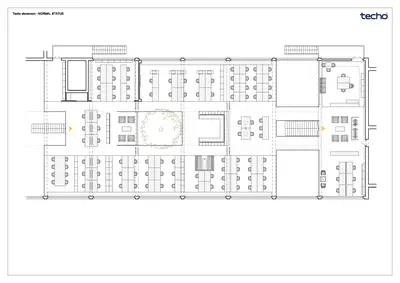 Original state
Original state
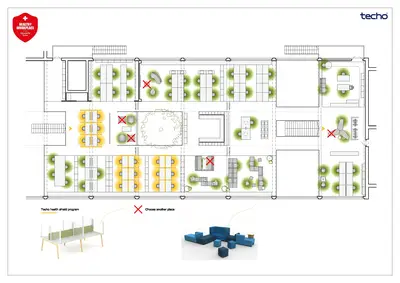 Healthy workplace solution
Healthy workplace solution
New rules
Experts from Cushman & Wakefield who devised their own “6-feet office” concept, and other experts point out that safety will be founded on two main pillars: maintain safe distance and improving hygiene conditions.
For the majority of employees there will be certain new rules that at the start will seem unnatural and will disturb the “comfort” that they had got used to in the office. It will therefore be up to managers to help people understand that the new rules are there to protect their health. After all, we quickly adjusted to the measures introduced to protect health in other public spaces.
The restrictions are not drastic; they are primarily about changing some of the ways we behave. It requires a sensitive and patient approach.
How to prepare your office according to the International Health Organisation?
advice-for-workplace-clean-19-03-2020
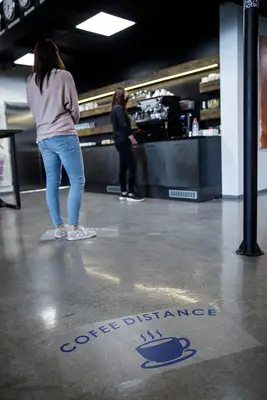
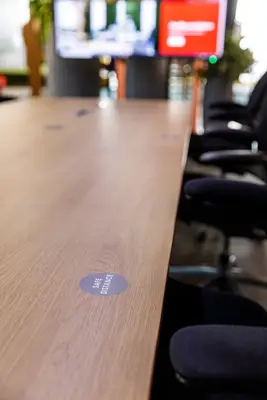 Do you want to make the changes as comfortable as possible for your employees? Use a simple signage system and clear instructions.
Do you want to make the changes as comfortable as possible for your employees? Use a simple signage system and clear instructions.
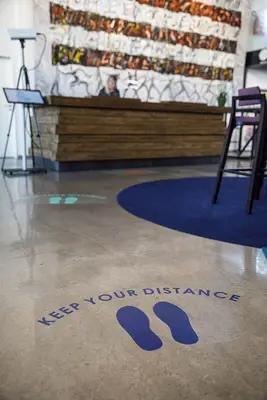
1. Maintain the recommended distancing
From the perspective of maintaining safe distancing the most high-risk areas are reception, open-plan offices and meeting rooms.
Rules need to be correctly set right from the building entrance. Use visual elements, such as sticker-signs on the floor, to mark out the required distancing at reception, in front of barriers or lifts. The simpler the system you use, the easier it will be for your employees to stick to the rules. Don’t be afraid to also apply some humour.
Floor signage can also help direct the movement of employees around the building, along corridors and floors – and in shared space they can demarcate the distance of 6 feet and also indicate the required direction of movement.
Tip: Experts recommend introducing a clockwise one-way system. Maybe this idea will seem comic to you, or difficult to apply, but this is a clear method that is commonly used regulate the movement of people in health facilities.
Visual aids such as stickers can also be used for distancing at workplaces – e.g. marking out circular safe zones around each desk. In conference rooms the correct positioning of chairs can be marked out with stickers. A software application is recommended to manage the occupancy of meeting rooms.
1.
Signage system
You can use: floor stickers, stickers on workstations, in meeting rooms etc.
2.
Dividers
Screens, screen extensions, free-standing screens, modular furniture, smart lockers.
3.
Layout change
Long-term – change of layout and rebuilding existing offices. Short-term – removing chairs together with signage system will ensure that employees maintain safe distancing.
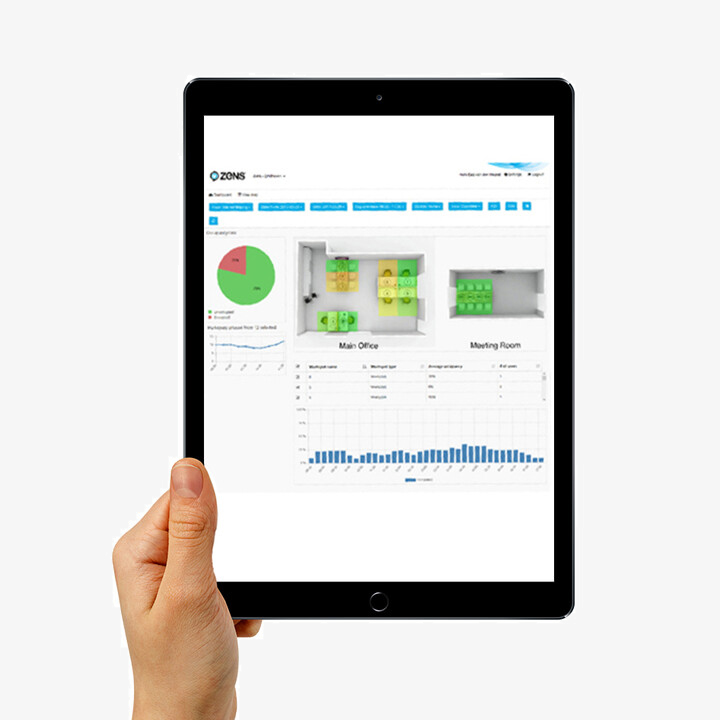
How to find a free meeting room, a colleague, or restrict unnecessary movement around the office
Ahrend Smart Office is a specific solution thanks to which you will have a perfect overview of the occupancy in all your offices, or the movement and current location of your colleagues. You can find your way around the application thanks to a plan view, so you can see if the building is full, and you can reserve individual spaces and workstations. This reduces unnecessary movement of employees in the building when looking for a suitable meeting room or workstation. A smart method to manage safe distancing in the office.
2. Introduce thorough hygiene measures
Insufficient distance between individual desks can be solved in the short-term by installing plexiglass screens. From a long-term perspective it is appropriate to consider a possible layout change, where the nature of your office space allows. Employees will certainly not want to give up on a pleasant work environment, and it will therefore be up to you to turn the individual restrictions into an opportunity for a positive change.
Tip: If you quickly need to establish distance between two workstations, use one workstation as a small “garden”. Plants create a natural barrier, and they have a positive influence on the health and mental wellbeing of your employees.
Remember that each workstation must be regularly disinfected, and therefore every employee should have at hand disinfectant for cleaning work surfaces, keyboard, mouse etc. at the start and end of every work period. In the case of shared workstations, it is possible to improve hygiene using disposable paper mats that an employee simply throws away when they leave at the end of the day.
Frequent and thorough cleaning is necessary for all workstations and common areas, and many companies right from the start of the COVID-19 threat quickly adjusted to the new measures. It is now standard to have a hand sanitizer dispenser at the entrance to buildings and at other key points within offices.
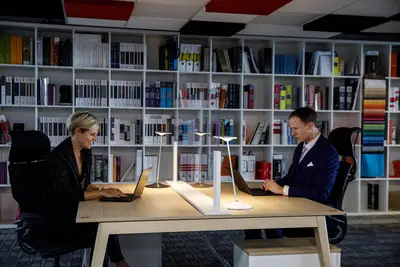
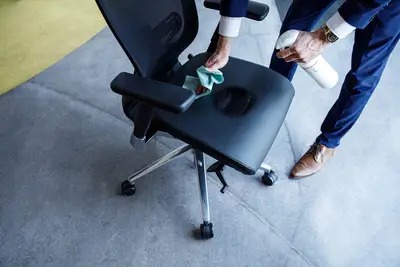
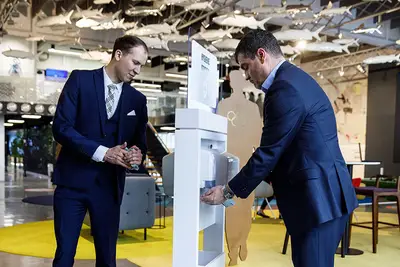
We are still at the start
However, none of the above represent a definitive solution. One of the critical points that will need to be resolved in most offices is air-conditioning. Its adjustment will certainly require a period longer than a few weeks, and the current situation will probably require many companies to invest in modern technology in the near future. The same will also apply to furnishings and other equipment.
Some of the above-mentioned measures will not be possible in a fully occupied office. This is another area where companies will look for smart solutions. Today we can already see firms introducing new shift operation where employees alternate daily, or in two shifts a day.

The future is open, but it is highly likely we will see fundamental changes. Employers will have to provide a safe and healthy workplace for their employees. We will now focus on what companies require in this initial phase and step by step introduce crisis measures. However, we are already working on longer-term sustainable solutions.
Do you need help?

If you are looking for a partner to help you with the first necessary changes to your office, our team is ready to provide you with support. We can help with moving, rearranging layouts, and disposal of old furniture. Let us know what we can do for you.
- Moving and rearrangement of furniture
- Disposal of old furnishings
- Consultation